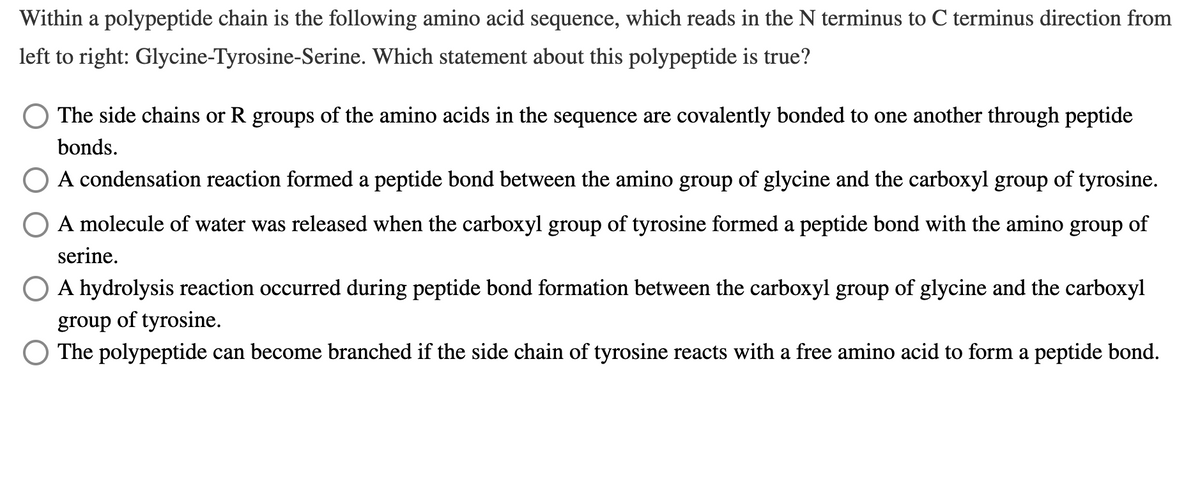Within a polypeptide chain is the following amino acid sequence, which reads in the N terminus to C terminus direction from left to right: Glycine-Tyrosine-Serine. Which statement about this polypeptide is true? The side chains or R groups of the amino acids in the sequence are covalently bonded to one another through peptide bonds. A condensation reaction formed a peptide bond between the amino group of glycine and the carboxyl group of tyrosine. A molecule of water was released when the carboxyl group of tyrosine formed a peptide bond with the amino group of serine. A hydrolysis reaction occurred during peptide bond formation between the carboxyl group of glycine and the carboxyl group of tyrosine. The polypeptide can become branched if the side chain of tyrosine reacts with a free amino acid to form a peptide bond.
Within a polypeptide chain is the following amino acid sequence, which reads in the N terminus to C terminus direction from left to right: Glycine-Tyrosine-Serine. Which statement about this polypeptide is true? The side chains or R groups of the amino acids in the sequence are covalently bonded to one another through peptide bonds. A condensation reaction formed a peptide bond between the amino group of glycine and the carboxyl group of tyrosine. A molecule of water was released when the carboxyl group of tyrosine formed a peptide bond with the amino group of serine. A hydrolysis reaction occurred during peptide bond formation between the carboxyl group of glycine and the carboxyl group of tyrosine. The polypeptide can become branched if the side chain of tyrosine reacts with a free amino acid to form a peptide bond.
Biology (MindTap Course List)
11th Edition
ISBN:9781337392938
Author:Eldra Solomon, Charles Martin, Diana W. Martin, Linda R. Berg
Publisher:Eldra Solomon, Charles Martin, Diana W. Martin, Linda R. Berg
Chapter3: The Chemistry Of Life: Organic Compounds
Section: Chapter Questions
Problem 9TYU: Which of the following levels of protein structure may be affected by hydrogen bonding? (a) primary...
Related questions
Question
please see attached

Transcribed Image Text:Within a polypeptide chain is the following amino acid sequence, which reads in the N terminus to C terminus direction from
left to right: Glycine-Tyrosine-Serine. Which statement about this polypeptide is true?
The side chains or R groups of the amino acids in the sequence are covalently bonded to one another through peptide
bonds.
O A condensation reaction formed a peptide bond between the amino group of glycine and the carboxyl group of tyrosine.
A molecule of water was released when the carboxyl group of tyrosine formed a peptide bond with the amino group of
serine.
O A hydrolysis reaction occurred during peptide bond formation between the carboxyl group of glycine and the carboxyl
group of tyrosine.
O The polypeptide can become branched if the side chain of tyrosine reacts with a free amino acid to form a peptide bond.
Expert Solution
This question has been solved!
Explore an expertly crafted, step-by-step solution for a thorough understanding of key concepts.
This is a popular solution!
Trending now
This is a popular solution!
Step by step
Solved in 2 steps

Knowledge Booster
Learn more about
Need a deep-dive on the concept behind this application? Look no further. Learn more about this topic, biology and related others by exploring similar questions and additional content below.Recommended textbooks for you

Biology (MindTap Course List)
Biology
ISBN:
9781337392938
Author:
Eldra Solomon, Charles Martin, Diana W. Martin, Linda R. Berg
Publisher:
Cengage Learning

Human Heredity: Principles and Issues (MindTap Co…
Biology
ISBN:
9781305251052
Author:
Michael Cummings
Publisher:
Cengage Learning

Biology (MindTap Course List)
Biology
ISBN:
9781337392938
Author:
Eldra Solomon, Charles Martin, Diana W. Martin, Linda R. Berg
Publisher:
Cengage Learning

Human Heredity: Principles and Issues (MindTap Co…
Biology
ISBN:
9781305251052
Author:
Michael Cummings
Publisher:
Cengage Learning